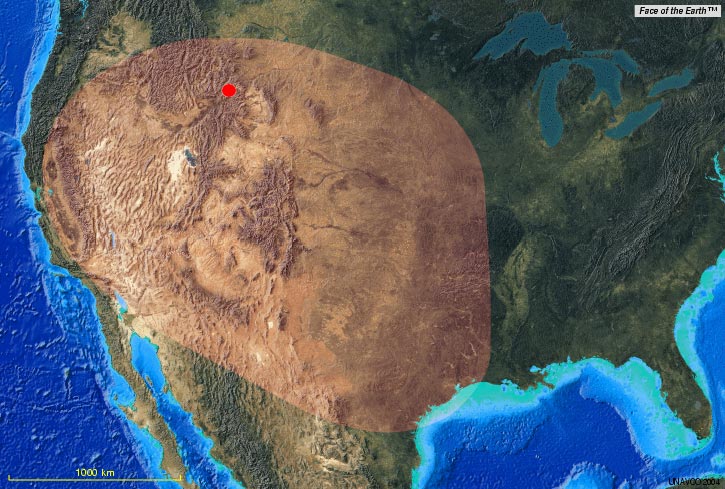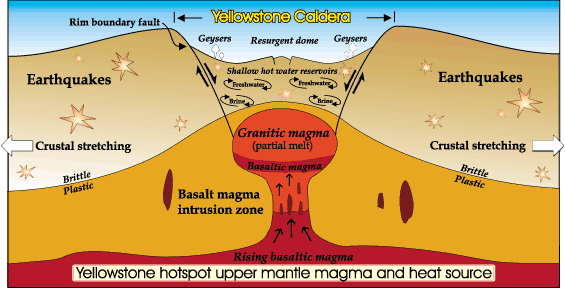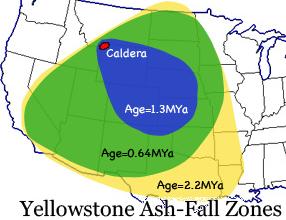UPDATE: February 2, 2010 Hundreds of Quakes Are Rattling Yellowstone By KIRK JOHNSON DENVER - In the last two weeks, more than 100 mostly tiny earthquakes a day, on average, have rattled a remote area of Yellowstone National Park in Wyoming, putting scientists who monitor the park's strange and volatile geology on alert. Researchers say that for now, the earthquake cluster, or swarm - the second-largest ever recorded in the park - is more a cause for curiosity than alarm. The quake zone, about 10 miles northwest of the Old Faithful geyser, has shown little indication, they said, of building toward a larger event, like a volcanic eruption of the type that last ravaged the Yellowstone region tens of thousands of years ago. The area is far from any road or community, and the park is relatively empty in winter. Swarms of small quakes, including a significant swarm last year, are relatively common. But at a time when the disastrous earthquake in Haiti on Jan. 12 has refocused global attention on the earth's immense store of tectonic energy, scientists say that the Yellowstone swarm, if only because of its volume, bears close observation: as of Sunday, there had been 1,608 quakes since Jan. 17. "We're not seeing a pattern that is really discernible yet," said Henry Heasler, a coordinating scientist for the Yellowstone Volcano Observatory, a joint venture of Yellowstone, the United States Geological Survey and the University of Utah. Dr. Heasler said plans were in place to intensify observations in case the swarm continued for a long time or got larger. "We're ready to ramp up," he said, including using flights to monitor the area. Researchers at the University of Utah's Seismograph Stations who have tracked Yellowstone swarms said they thought it was coincidental that another big swarm of more 1,000 quakes had struck the park just over a year ago. At the time, it was the second-biggest cluster recorded there. The largest swarm was in 1985, when 3,000 earthquakes struck over three months. Last year's swarm, beneath northern Yellowstone Lake, had a specific track of alignment, with the earthquakes moving north and growing shallower from the initial quake area, said Robert B. Smith, a professor of geophysics at the University of Utah and a science coordinator at the Yellowstone Volcano Observatory. The mostly smaller quakes in the current swarm, he said, are more like a cloud, with no directional pattern, similar to what scientists saw in a big swarm at the park in 1999. "We think the crust beneath Yellowstone is highly fractured already, so we're getting stress release in these earthquakes - a displacement of millimeters," Dr. Smith said. Dr. Heasler said researchers use the park-s geologic wonders, like Old Faithful - which spews steam and water on schedule, plus or minus 10 minutes - as indicators of the effects of quake activity. He and his team look for changes in water temperature, or mud plumes in hot pools that otherwise run clear. This swarm, he said, seems not to have affected any of those natural monitors, though he emphasized that analysis was continuing. Attention to earthquakes in general has soared since the quake in Haiti. For instance, visits to the United States Geological Survey’s Earthquake Hazards Program Web site increased fivefold after the quake, to more than a million a day, compared with the numbers a month earlier, an agency spokeswoman said. Dr. Heasler said park visitors had been encouraged to help with the research by telling park officials if they felt the ground shake. UPDATE: November 09, 2009 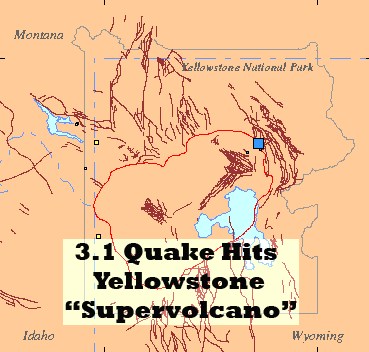 Background Mild tremors in the Yellowstone National Park are not rare. The region, with its geysers, like "Old Faithful," and thermal pools has long been known as an area of geological instability. Despite the lack of a cone-shaped mountain or obvious volcano, scientists now know that almost the entire Yellowstone area is an enormous caldera. There is ample evidence of huge volcanic explosions from the Yellowstone volcano in the past. Ash deposits reveal the eruptions happen with some periodicity and note the last catastrophic explosion was just 70,000 years ago. According to these geologic records, we are long overdue for the next "big one."
With the discovery that this huge caldera exists, scientists were startled to learn that the surface of the caldera is bulging. Last year a report in the journal Science found the park's central region was rising up at a rate of up to 7cm a year due to the movement of a pool of magma several miles below the surface. Scientists measured over two feet of uplift during the period 1923-1985. This suggests that the underlying magma may be building up just below the surface of the land, preparing for a major "super-volcano" event. But as they carefully monitored the seismic activity in the region, they were comforted by the relative stability of both the frequency and number of earth tremors. But that has just changed. More than 250 tremors have been recorded since Friday, December 26th, 2008, including nine greater than magnitude 3.0 on the Richter scale, according to the University of Utah. The largest, a magnitude 3.9, struck on Saturday and the area was shaken by a 3.3 tremor just after midday on Monday, December 29th. 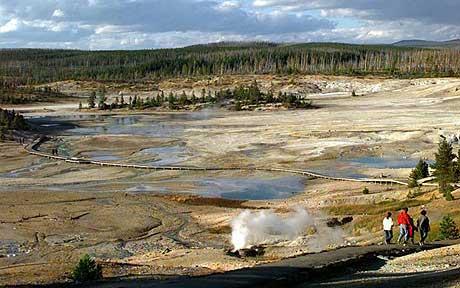 While earthquakes are common in the giant park, which covers parts of Wyoming, Idaho and Montana and experiences about 1,000 to 2,000 tremors a year, the intense burst of seismic activity lasting several days is being described as "unusual." "They're certainly not normal," said Robert Smith, a professor of geophysics at the University of Utah. "We haven't had earthquakes of this energy or extent in many years." Mr Smith, director of the Yellowstone Seismic Network, which operates seismic stations around the park, said the earthquakes have ranged in strength from barely detectable to Saturday's 3.9. A magnitude 4 earthquake is capable of producing moderate damage. But the threat of earthquakes pales compared to what most scientists fear most -- the collapse of the caldera and the ingnition of a super-volcano.
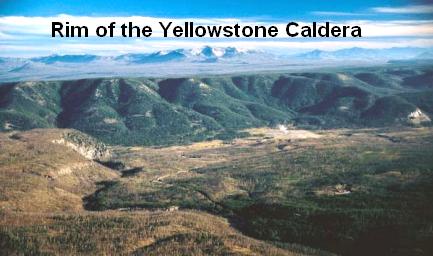 "This is an active volcanic and tectonic area, and these are the kinds of things we have to pay attention to," he said. "We might be seeing something precursory." "Could it develop into a bigger fault or something related to hydrothermal activity? We don't know. That's what we're there to do, to monitor it for public safety." So far, all the quakes have been centred beneath the northwest end of Yellowstone Lake. No damage has been reported and a park spokeswoman said there does not yet appear to be cause for alarm.
Mr Smith said it was difficult to say what might be causing the current tremors. He added that the park's famous geysers and hot springs were a reminder of the magma underground which turns ground water to steam. "That's just the surface manifestation of the enormous amount of heat that's being released through the system," he said. In 1959, a magnitude 7.5 earthquake near Hebgen Lake just west of Yellowstone National Park triggered a landslide that killed 28 people. If the current earthquake activity continues to increase, the fragile caldera could collapse in on itself, opening up the pressurized magma and causing an explosion with ash and debris that would destroy crops and impede life all the way to New York City. Is this happening now before our eyes? We'll have to wait and see.
Comments:
|
Other unexplained photos on this site:
If you have a suggestion or a photo to submit, send it to:
Editor/viewzone.com
myristicin@hotmail.com
Top 9 Viewzone Stories
Left Brain:Right Brain
We have two brains that don't always argee and sometimes fight for control. Can facial features shed light on which brain controls our thoughts? Great article by Dan Eden with photographic analysis of many popular figures.
The Luscher Personality Test
Select your favorite colors and see what this on-line test reveals. Requires JavaScript.
We're Not From Here!
Recent evidence suggests that we are not part of the Milky Way but a dwarf galaxy being assimilated.
Smallpox: The Weapom
A review of what we know about this deadly virus. Is it gone? Really?
How to read eyes!
What do professional interrogators look for to see if you are telling a lie? Can anyone do this?
Decorating with Feng Shui
Nancy Uon gently introduces you to the basics and shows how to best arrange your living space.
Handwriting Analysis
What can be learned about you through your handwriting. Some famous mysteries are described and lessons are given.
Money: what is it?
This Dan Eden article starts with the history of money and describes the current economics that have resulted in the rapidly declining US Dollar.
The Philadelphia Experiment
Did the US Navy succeed in making the US Liberty invisible?
